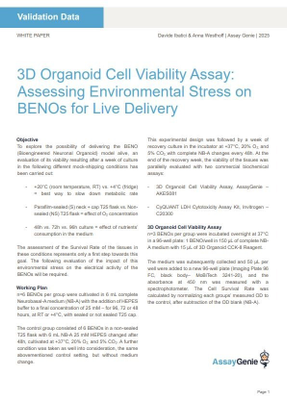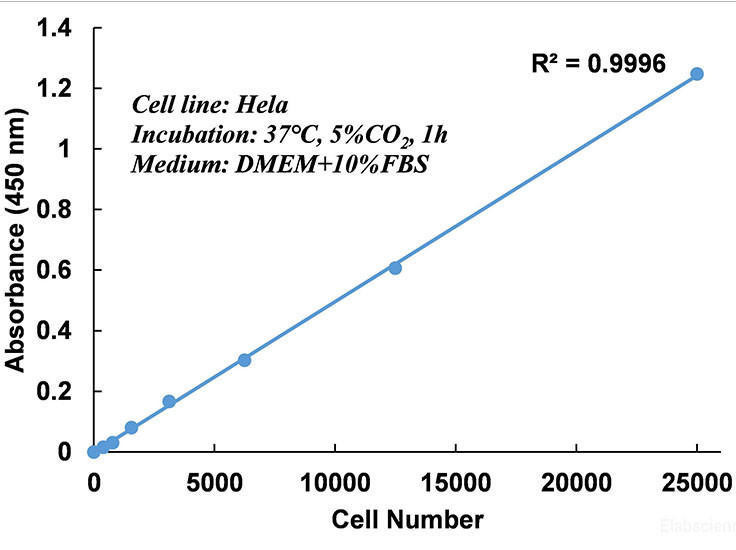3D Organoid Cell Viability Assay: Assessing Environmental Stress on BENOs for Live Delivery
3D Organoid Cell Viability Assay (AKES081) effectively measures BENO model viability across different storage conditions. AKES081 detects significant viability differences, particularly the negative impact of +4°C (fridge) storage over time, confirming its sensitivity to environmental stress. AKES081 successfully differentiates viability effects based on temperature and duration, while flask sealing (O₂ concentration) shows no significant influence. Raw absorbance values and ANOVA analysis confirm AKES081 ability to detect statistically significant differences between control and test conditions. AKES081 provides a reliable tool for evaluating viability in live BENO delivery, but further validation with a non-viable tissue control group is recommended.
Key Findings:
- 3D Organoid Cell Viability Assay (AKES081) effectively measures BENO model viability across different storage conditions.
- AKES081 detects significant viability differences, particularly the negative impact of +4°C (fridge) storage over time, confirming its sensitivity to environmental stress.
- AKES081 successfully differentiates viability effects based on temperature and duration, while flask sealing (O₂ concentration) shows no significant influence.
- Raw absorbance values and ANOVA analysis confirm AKES081 ability to detect statistically significant differences between control and test conditions.
- AKES081 provides a reliable tool for evaluating viability in live BENO delivery, but further validation with a non-viable tissue control group is recommended.
3D Organoid Cell Viability Assay: Assessing Environmental Stress on BENOs for Live Delivery
Objective
To explore the possibility of delivering the BENO (Bioengineered Neuronal Organoid) model alive, an evaluation of its viability resulting after a week of culture in the following different mock-shipping conditions has been carried out:
- +20°C (room temperature, RT) vs. +4°C (fridge) = best way to slow down metabolic rate
- Parafilm-sealed (S) neck + cap T25 flask vs. Non-sealed (NS) T25 flask = effect of O2 concentration
- 48h vs. 72h vs. 96h culture = effect of nutrients’ consumption in the medium
The assessment of the Survival Rate of the tissues in these conditions represents only a first step towards this goal. The following evaluation of the impact of this environmental stress on the electrical activity of the BENOs will be required.
Working Plan
n=6 BENOs per group were cultivated in 6 mL complete Neurobasal-A medium (NB-A) with the addition of HEPES buffer to a final concentration of 25 mM – for 96, 72 or 48 hours, at RT or +4°C, with sealed or not sealed T25 cap.
The control group consisted of 6 BENOs in a non-sealed T25 flask with 6 mL NB-A 25 mM HEPES changed after 48h, cultivated at +37°C, 20% O2, and 5% CO2. A further condition was taken as well into consideration, the same abovementioned control setting, but without medium change.
This experimental design was followed by a week of recovery culture in the incubator at +37°C, 20% O2, and 5% CO2, with complete NB-A changes every 48h. At the end of the recovery week, the viability of the tissues was parallelly evaluated with two commercial biochemical assays:
- 3D Organoid Cell Viability Assay, AssayGenie – AKES081
- CyQUANT LDH Cytotoxicity Assay Kit, Invitrogen – C20300
3D Organoid Cell Viability Assay
n=3 BENOs per group were incubated overnight at 37°C in a 96-well plate: 1 BENO/well in 150 µL of complete NB-A medium with 15 µL of 3D Organoid CCK-8 Reagent.
Page 1
The medium was subsequently collected and 50 µL per well were added to a new 96-well plate (Imaging Plate 96 FC, black body– MoBiTech 3241-20), and the absorbance at 450 nm was measured with a spectrophotometer. The Cell Survival Rate was calculated by normalizing each groups’ measured OD to the control, after subtraction of the OD blank (NB-A).


- Blank = fresh Neurobasal-A complete
- Ctrl = 37°C - 5% CO2 – medium change after 48h
- Ctrl w/o = 37°C - 5% CO2 – No medium change
Results
A. 3D Organoid Cell Viability Assay
Analysis of the Variance (one-way ANOVA) between the groups. The results show how, in the considered setting, the assay seems to be able to unveil significant differences between some of the conditions. It is possible to appreciate a tendency of decreasing viability correlating with time in the +4°C condition.
Time, which also exacerbates differences related to the two storage temperatures at the same timepoint, as data from the groups RT-96h vs. 4°C-96h show. Contrarily, the RT storage seems to retain a constant viability through the course of the experiment.
n=3 BENOs/group. Pairwise differences between groups were assessed by post-hoc Tukey’s multiple comparisons test (*p≤0.05; **p≤0.01; ***p≤0.001; ****p≤0.0001).
B. Raw OD Data
To statistically confront the mock shipping test conditions with the control group, it is necessary to consider the raw absorbance values: one-way ANOVA was performed, highlighting a significant difference between the control group and the two 4°C-96h groups, as expected.
n=3 BENOs/group. Pairwise differences between groups were assessed by post-hoc Tukey’s multiple comparisons test (*p≤0.05; **p≤0.01; ***p≤0.001; ****p≤0.0001).
C. Single Parameters
Additionally, the assay succeded in distinguishing the effects of temperature and time alone. The values were pooled considering only one parameter at a time: Welch‘s t-tests (Temperature and Sealed/Non Sealed plots) and one-way ANOVA (Time plot) were performed.
The results suggest, that the room temperature storage and a shorter time in this condition, allow a better preservation of viability of the model, while the sealing of the flask, namely O2 concentration, apparently does not influence the survival rate in this setting.
n=18 BENOs/group for Temperature and Sealed/Non Sealed plot, all groups passed normality test (****p≤0.0001; ns=not significant). n=12/group in the Time plot, where pairwise differences between groups were assessed by post-hoc Tukey’s multiple comparisons test (**p≤0.01).
Page 2
D. Temperature and Time
Since the impact of the sealing does not look predominant, for statistical purposes S and NS groups were grouped together. This setting highlights the determinant effect of temperature on the survival rate: the RT groups all significantly register higher percentages than their 4°C counterparts, with a time-dependent amplitude.
n=6 BENOs/group, one-way ANOVA was performed, and pairwise differences between groups were assessed by post-hoc Tukey’s multiple comparisons test (*p≤0.05; **p≤0.01; ***p≤0.001; ****p≤0.0001).
E. CyQUANT Cytotoxicity LDH Assay
The test is performed directly on the medium and not on the tissues, therefore we were able to measure at both time points, before and after recovery, but for comparison to the 3D Organoid Cell Viability Assay, only the latter is here shown.
Since the tissues from each group have been kept in the same flask, the assay has been performed in technical triplicates. For this reason, just the mean value for every group is depicted.
Here, after normalization, every experimental condition shows distinctively different values in comparison to the control group, including the control without medium change group. These values are all fluctuating around a 6% higher cytotoxicity than the control, with 100% value being instead a biological triplicate sample of organoid lysis.
Conclusion
The collected data is definitely realistic, and demonstrates that AssayGenie‘s 3D Organoid Cell Viability Assay is able to distinguish between different treatments/conditions in our BENO model.
To assess the sensitivity of the assay, a statistically more robust experiment would be required, comprising of at least a group of tissues known to be not viable, which now were unfortunately not available.
Page 3
Meet Some of the Genie Team!
Recent Posts
-
What Are Oligodendrocytes? Functions, Markers & Disease Links
What Are Oligodendrocytes? Functions, Markers & Disease LinksOligodendrocytes are pivo …24th Sep 2025 -
Complete T Helper Cell Guide: Th1, Th2, Th17 & Functions - Your Ultimate Resource from Assay Genie
Complete T Helper Cell Guide: Th1, Th2, Th17 & Functions - Your Ultimate Resource from …27th Aug 2025 -
Apoptosis Unveiled: Your Complete Guide to Intrinsic & Extrinsic Pathways
Apoptosis Unveiled: Your Complete Guide to Intrinsic & Extrinsic PathwaysAt Assay Geni …27th Aug 2025
























